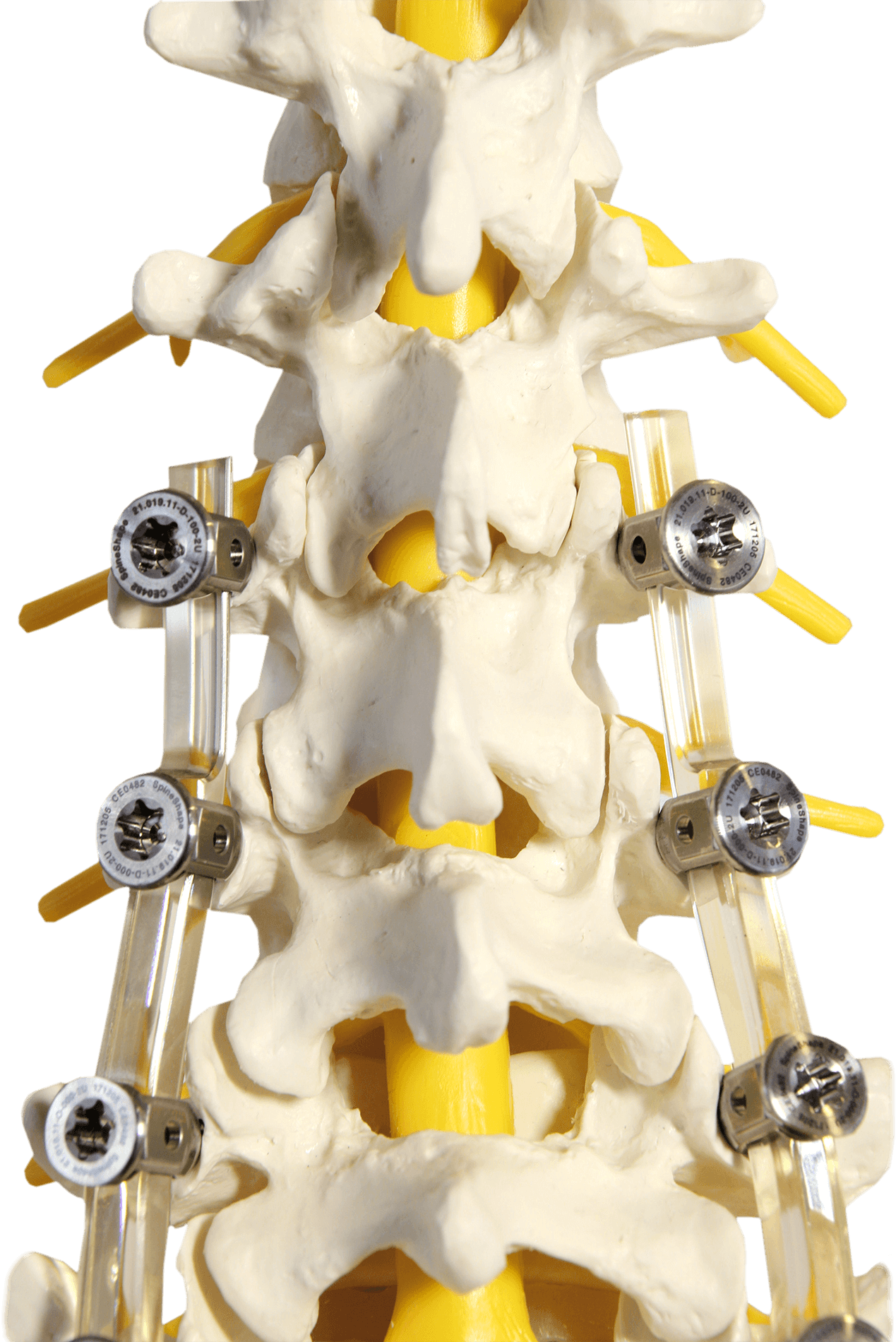SpineShape
System IV
Dynamic stabilisation of the lumbar spine with three selectable flexibilities. Quality of life and zest for life are returned.
The biomechanical principle of the dynamic stabilisation of the lumbar spine consists in the control of uncoordinated and thus painful relative movements between vertebral bodies. This kind of implant does not replace any tissues. Depending on the chosen rod flexibility, structures with more or less load sharing are added. Consequently, the implantation of such a system is reversible.
MORE INFO
With the insertion of the connecting rods approximately at the location of the facet joints, these facet joints are maximally being discharged. Therefore, pain due to arthrosis or capsular stretching may be eliminated. With this implantation set-up the natural kinematics (instantaneous centers of rotation) is only minimally altered and the loading stimulus of the intervertebral disc is maintained. In addition, the dorsal bulging of the disc may be reduced which might be beneficial in the case of nerve root irritation. Finally the global inclination of the disc may also be reduced what may diminish the danger of disc herniation.
Mimic of anatomy
The connection rods made of polymeric material mimic natural ligaments (collagenous structures) and provide comparable viscoelastic properties. They behave in a similar manner under tension and flexion loads and, in addition, are also capable to carry compression loads. The demanding anchorage, in analogy, is assured with the sophisticated interaction between pedicle screw and clamp screw.
patients
years as longest follow-up
years of experience
made in switzerland

The stepped region of the Varistab™ exhibits a reduced profile to allow for an elastic coupling of the adjacent motion segment.
The SpineShape System IV consists of PCU (polycarbonateurethane) rods and titanium pedicle screws.
The SpineShape System IV consists of PCU (polycarbonateurethane) rods having a dedicated cross section with plane parallel sides. Patents are issued for this cross section allowing for a safe and at the same time smooth anchorage of the rod through unique pedicle and clamp screws made of titanium alloy. The rods exist in three different flexibilities (high-flex, mid-flex and low-flex). For the mid-flex and low-flex rods a stepped version (Varistab™) is further available, allowing the connection of an adjacent segment with higher flexibility for cases where a fusion is expected. A great advantage of the Varistab™ includes the use of the same type of clamp screws and pedicle screws for the stepped end, where only a longer version of the clamp screw is required. The implants (rods, pedicle screws and clamp screws) are supplied in sterile condition after gamma irradiation.
Regeneration of the intervertebral disc
Cases are reported where intervertebral discs are re-accommodating water following the implantation of dynamic stabilisation systems. A plausible explanation could read as follows: With the implantation of a dynamic stabilisation system the hydrostatic pressure inside the intervertebral disc may be decreased, thus increasing the oncotic pressure (water content in proteins).
Elastic coupling
With the low-flex connecting rods, a motion segment can be stabilised to a degree, where a spontaneous fusion could occur. The fusion of a motion segment often leads to an excessive loading of the adjacent segment, which, according to recent knowledge, should be protected. Therefore connecting rods capable to achieve fusions should provide transition features allowing an elastic coupling of adjacent segments for the protection from excessive loads.
Pedicle screws exist in 17 sizes available in sets packed with two each, including two normal clamp screws. Rods are available as standard version (normal clamp screws) and Varistab™ (long clamp screws).
| Art.-No. | Thread length | Thread diameter |
|---|---|---|
| 21.018.11-540-S | 40 mm | 5.4 mm |
| 21.018.11-545-S | 45 mm | 5.4 mm |
| 21.018.11-550-S | 50 mm | 5.4 mm |
| 21.018.11-640-S | 40 mm | 6.2 mm |
| 21.018.11-645-S | 45 mm | 6.2 mm |
| 21.018.11-650-S | 50 mm | 6.2 mm |
| 21.018.11-655-S | 55 mm | 6.2 mm |
| 21.018.11-735-S | 35 mm | 7.0 mm |
| 21.018.11-740-S | 40 mm | 7.0 mm |
| 21.018.11-745-S | 45 mm | 7.0 mm |
| 21.018.11-750-S | 50 mm | 7.0 mm |
| 21.018.11-755-S | 55 mm | 7.0 mm |
| 21.018.11-835-S | 35 mm | 7.8 mm |
| 21.018.11-840-S | 40 mm | 7.8 mm |
| 21.018.11-845-S | 45 mm | 7.8 mm |
| 21.018.11-850-S | 50 mm | 7.8 mm |
| 21.018.11-855-S | 55 mm | 7.8 mm |
Rods exist in 5 versions. Straight standard rods are packed with 1 each and Varistab™ rods with 2 each with following article numbers:
| Art.-No. | Flexibility | Type |
|---|---|---|
| 21.012.21-200 | high-flex | prismatic (standard rod) |
| 21.012.23-200 | mid-flex | prismatic (standard rod) |
| 21.012.25-200 | low-flex | prismatic (standard rod) |
| 21.015.23-200 | mid-flex | stepped (Varistab™) |
| 21.015.25-200 | low-flex | stepped (Varistab™) |
Conformity
The implants and instruments are CE marked. According to the medical device directive 93/42/EEC the implants belong to the class IIb and the instruments to the class I
Changes reserved.